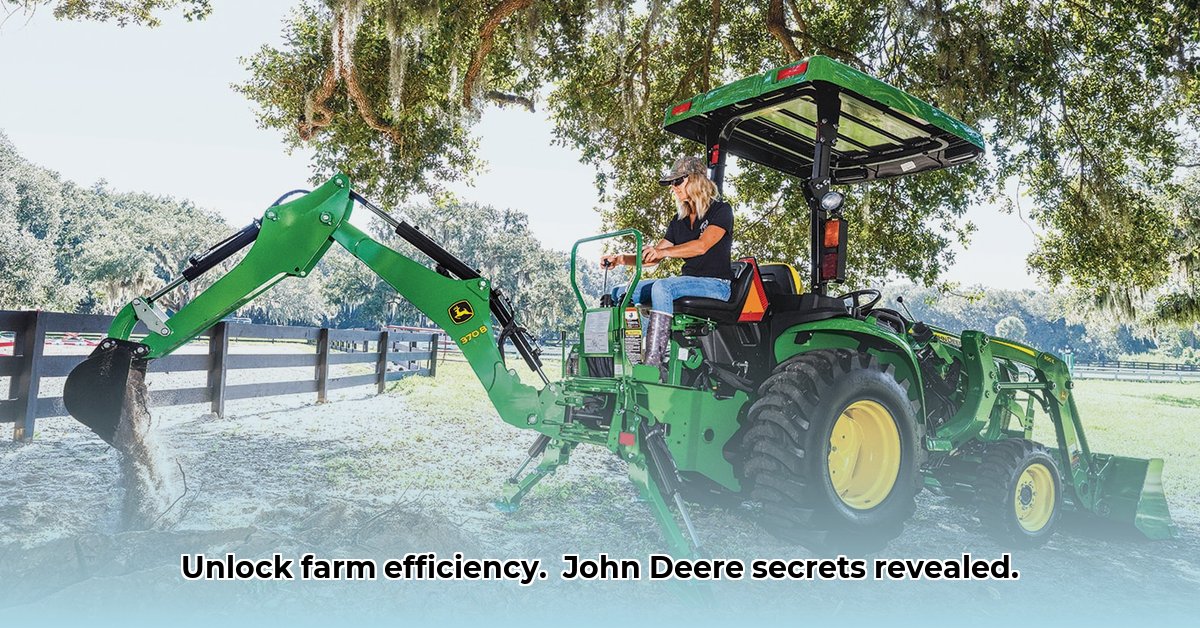
John Deere Attachments for Tractors: Optimizing Productivity and Sustainability
Boosting farm efficiency is crucial for modern agriculture. John Deere tractor attachments offer a powerful solution, transforming your tractor into a versatile machine capable of handling various tasks, from planting to harvesting. However, navigating the extensive range of options requires careful planning to ensure both productivity gains and alignment with sustainable farming practices. This guide will equip you with the knowledge to make informed decisions. But first, let's consider a crucial question: How much time do you currently spend on manually intensive tasks that could be automated, potentially saving both labor and fuel? For more on tractor implements, check out this helpful resource: tractor wagons.
Expanding Your Farming Capabilities with John Deere Attachments
John Deere attachments dramatically expand your farm’s operational capabilities. Imagine the time saved by using a front-end loader to spread manure instead of manual labor. Or picture the precision of a GPS-guided planter, ensuring optimal seed placement and minimizing waste. These are just examples of the efficiency improvements possible. These attachments allow you to handle a broader range of tasks more efficiently, reducing labor costs and boosting overall productivity. Regardless of your specific needs – tillage, planting, harvesting, or resource management – the right attachments can simplify complex operations and improve your bottom line. A recent study by Iowa State University found that utilizing appropriate implements can increase efficiency by up to 40%, depending on the specific task and farm size.
Choosing the Right John Deere Tractor Attachments: A Practical Guide
Selecting the optimal attachments involves a strategic approach. Follow these steps:
Assess Your Needs: Identify your farm's biggest challenges—tilling, planting, hay baling, etc. List the tasks you aim to mechanize. This will help narrow your choices.
Verify Compatibility: Ensure the selected attachment is compatible with your tractor model. Consult your tractor's manual or the John Deere website; incorrect attachments can lead to operational issues.
Explore Key Features: Consider features like John Deere's Quik-Knect™ (quick attachment system) and Load-N-Go™ (easy operation) to minimize downtime and enhance efficiency. Ease of maintenance is also crucial for long-term cost-effectiveness.
Budget Strategically: Attachments represent a significant investment. Factor in the initial price, maintenance, fuel consumption, and potential repairs.
Explore Financing Options: John Deere and other financing partners provide leasing and financing arrangements to ease the financial burden.
Prioritize Durability: Invest in durable attachments to reduce replacement costs and minimize downtime. This contributes to both your bottom line and environmental sustainability by reducing waste.
John Deere Attachments: A Balanced Perspective of Advantages and Disadvantages
While John Deere attachments offer significant advantages, it's crucial to consider potential drawbacks:
| Feature | Pros | Cons |
|---|---|---|
| Variety | Extensive selection for diverse farming needs and tractor models. | Overwhelming choice can complicate decision-making. |
| Ease of Use | Innovative features like Quick-Connect simplify attachment changes. | Specialized attachments require training and experience for optimal use. |
| Durability | Generally robust and designed for demanding agricultural tasks. | Still subject to wear and tear; regular maintenance is essential. |
| Cost-Effectiveness | Increased efficiency leads to potential savings in labor and operating costs, boosting profits. | Substantial upfront investment; ongoing maintenance adds to the total cost. |
| Sustainability | Improved efficiency can result in better fuel economy and reduced resource consumption. | Manufacturing and disposal have environmental impacts; sustainable practices are essential. |
Sustainable Farming with John Deere Attachments: A Holistic Approach
While John Deere attachments improve efficiency, sustainable farming demands a broader perspective.
Meticulous Maintenance: Regular maintenance extends equipment lifespan, reducing waste from premature replacements and improving fuel efficiency.
Optimized Fuel Consumption: Choose attachments known for fuel efficiency to minimize environmental impact and reduce operating costs.
Precision Agriculture Integration: Combining Deere attachments with precision ag technologies like GPS guidance and variable-rate application optimizes resource use (fertilizers, pesticides).
Responsible Disposal: Plan for end-of-life equipment management, considering recycling options for minimal environmental impact.
Dr. Anya Sharma, Professor of Agricultural Engineering at Cornell University, emphasizes, "Sustainable farming isn't solely about equipment; it's about integrating mindful practices into every stage, from purchase to disposal. Using efficient attachments is one piece of the puzzle, but thoughtful planning is crucial for long-term environmental responsibility.”
How to Calculate the Total Cost of Ownership (TCO) for John Deere Farm Implements
Understanding Total Cost of Ownership (TCO) is vital for informed investment decisions in agricultural machinery. It's crucial to analyze more than just the initial purchase price.
Key TCO Components for John Deere Implements
TCO encompasses various costs throughout the implement's lifespan:
- Purchase Price: The initial cost of the attachment.
- Depreciation: The decrease in value over time. Consult an accountant on the optimal depreciation accounting method for your tax situation.
- Interest (if applicable): Payments on loans used to finance the purchase.
- Insurance: Premiums to protect your investment.
- Taxes: Property and other relevant taxes.
- Maintenance and Repairs: Costs associated with regular servicing and unforeseen repairs.
- Fuel Consumption: Operational fuel costs.
- Operator Labor: The cost of time spent operating the equipment.
- Storage: Costs associated with proper equipment storage.
- Technology Costs (John Deere Link): The initial and ongoing costs of precision agriculture technologies like JDLink™.
Step-by-Step TCO Calculation
- Gather Data: Compile all cost-related information.
- Calculate Annual Costs: Estimate annual expenses for each category.
- Estimate Equipment Lifespan: Research the typical lifespan of the chosen attachment.
- Calculate Depreciation: Use a suitable depreciation method to determine annual depreciation.
- Sum Annual Costs: Add all annual costs.
- Total Cost: Multiply the sum of annual costs by the estimated lifespan.
Maintaining a contingency fund for unexpected repairs is advisable. A thorough TCO analysis enables informed comparisons between different equipment options, maximizing long-term value. Remember, sustainable practices contribute to lower long-term costs by promoting fuel efficiency and reducing waste. A well-maintained implement will provide both economic and environmental benefits.